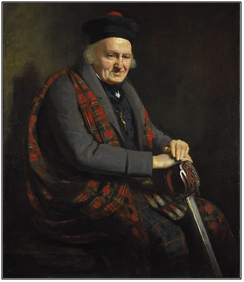Clan Grant Portraits
Robert Grant of Lurg, by an unknown artist, circa 1769 – The original painting of Robert Grant was in the large collection of portraits at Castle Grant. In the portrait, Lurg is wearing a coat and plaid in a tartan similar to the well-known government or Black Watch sett. It is said that he was a sergeant in the Independent Company formed by Colonel William Grant of Ballindalloch, circa 1725. Over time, the dark blue-green-black tartan became known as the hunting tartan of the Clan Grant.
Archibald Grant, younger of Monymusk (1697-1778), painted in Edinburgh by Richard Waitt, in 1715 – Sir Archibald Grant was painted in the uniform of the Royal Company of Archers, the ceremonial bodyguard of the King or Queen in Edinburgh. The uniform is said to be the oldest known example of a tartan associated with a specific Scottish military unit. Archibald Grant was the eldest son of Sir Francis Grant of Monymusk, Lord Cullen. The painting reportedly commemorated two important events in the subject’s life – his selection to the Royal Company of Archers in October 1714 and his being called to the Scots Bar one month later.
Patrick Grant, Padruig Grannd an Dubh Bruaich (1713-1824), painted by the noted Scottish portraitist, Colvin Smith, RSA, in 1822, Scottish National Portrait Gallery, Edinburgh – Patrick Grant was a Jacobite soldier from Strathdon, who fought against the government forces in the 1745 Rebellion. In 1822, at the age of 109, he was brought to Edinburgh and introduced to King George IV as “His Majesty’s oldest enemy”. The King was amused and subsequently authorized a small pension for Patrick and his daughter as an act of reconciliation.
Charles Grant, Member of Parliament (1746-1823), painted in 1819 by Henry Raeburn, oil on canvas, 300 cm. x 180 cm., in the collection of the Highland Council, on display in the Inverness Library – Charles Grant, the elder, was a Director of the East India Company (1793) and sometime Chairman of the Board (1805). He was a Member of Parliament (1802) and a great promoter of the Caledonian Canal and other construction projects in the highlands. He represented the county of Inverness in Parliament until 1818.
Sir Alexander Grant of Forres, 1st Baronet (1864-1937), painted by Samuel Henry William Llewellyn, circa 1935, in the University of Edinburgh Fine Art Collection – Sir Alexander was a self-made man. As a young lad, he secured employment in a bakery in Queensferry and worked his way up the corporate ladder to become Chairman and Managing Director of McVitie & Price, which later became part of the United Biscuit Company. Sir Alexander was raised to the rank of Baronet by Prime Minister Ramsay MacDonald. He was a generous benefactor of the city of Forres, the University of Edinburgh, and the National Library of Scotland.
Lieutenant John Patrick Grant, 2nd Battalion, Seaforth Highlanders, painted by Elizabeth Southerden Thompson, Lady Butler, in 1902 – The painting depicts an incident on the Northwest Frontier of India, now Pakistan, known as the Relief of Chitral, in 1895. The artist was a prominent Victorian era painter of British militaria. The painting is entitled “Stand Fast, Craigellachie” and is presently in the collection of the National War Museum, Edinburgh Castle.
Captain John Grant, Congash (1774-1861), painted by Colvin Smith in 1847, Grantown Museum & Heritage Trust – Captain Grant was the factor to the Earl of Seafield in Strathspey for many years. He was one of the principal leaders of the Clan Grant in the famous march on Elgin during the election campaign of 1820.
General Sir James Hope Grant, GCB, (1808-1875), by his brother, Sir Francis Grant, PRA, in 1853 – General Grant was the fifth and youngest son of Francis Grant of Kilgraston, formerly the Grants of Glenlochy in Strathavon. He entered the British Army in 1826 as a cornet in the 9th Lancers. He distinguished himself in China and during the first Anglo-Sikh War of 1845-46. He became a brigadier of cavalry in 1856 and took a leading part in quelling the Indian Rebellion and the retaking of Lucknow in 1857. In 1859, he was commander of British troops in China and Hong Kong with the rank of Lieutenant General and awarded the honor of Knight Grand Cross of the Order of the Bath. His final military assignment was Commander of the British Army at Aldershot, south of London. He retired with the rank of General in 1872.
William Grant of Congalton, near Edinburgh, The Skater, oil on canvas, 97” x 58”, painted in London by the noted American painter, Gilbert Stuart, in 1782 – William Grant was an advocate in Edinburgh and lived at Congalton, East Lothian. The painting is displayed in the National Gallery of Art, Washington, D.C. Gilbert Stuart studied under the well-known British artist Benjamin West. Some of his best known portraits were of George Washington, Martha Washington, Thomas Jefferson, and John Adams.
[A more comprehensive presentation of noteworthy descendants of the clan is available in “A History of The Clan Grant... Music and Art” under the heading “For Members Only.”]
James Grant, historian
Clan Grant Society – USA
standfast@charter.net









